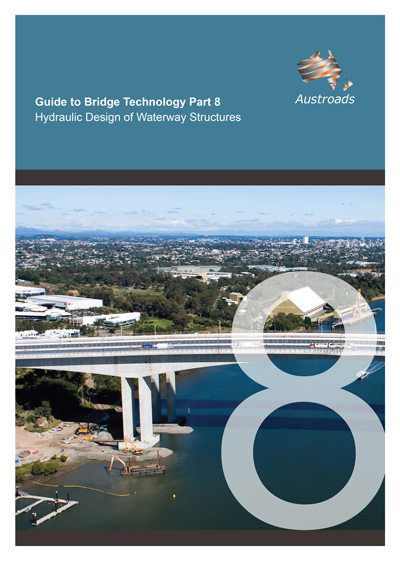Bridges

- Publication no: AGBT08-18
- ISBN: 978-1-925671-23-0
- Published: 19 February 2018
- Edition: 2.0
- Superseded
- PDF (free) Download
Guide to Bridge Technology Part 8 provides a guideline for issues related to the waterway design of bridges. It covers various topics such as design flood standards and estimation methods, general considerations in waterway design and design considerations of waterway structures. Design of new bridges for scour, scour countermeasures, as well as monitoring and evaluation of scour at existing bridge sites are also included.
This Guide reinstates the superseded Austroads’ 1994 Waterway Design: A Guide to the Hydraulic Design of Bridges, Culverts and Floodways. This version provides updated details and information based on the latest technology and incorporates the US Federal Highway Administration publications that are currently being used in Australian and New Zealand practices.
- 1. Introduction
- 1.1 Scope
- 1.2 Guide Structure
- 2. Design Floods
- 2.1 Design Flood Standards
- 2.1.1 General
- 2.1.2 Overall Design of Total Waterway
- 2.1.3 Serviceability Level
- 2.1.4 Serviceability Limit State
- 2.1.5 Ultimate Limit State
- 2.1.6 Environmental Impact
- 2.2 Estimation of Design Floods
- 2.2.1 Methods Available
- 2.2.2 At-site Flood Frequency Analysis
- 2.2.3 Regional Flood Methods
- 2.2.4 Unit Hydrographs
- 2.2.5 Runoff Routing Model
- 2.2.6 Estimation of ULS Floods
- 2.2.7 Field Observation of Floods
- 2.1 Design Flood Standards
- 3. General Considerations in Waterway Design
- 3.1 Introduction
- 3.2 Rivers and River Crossings
- 3.2.1 General
- 3.2.2 Types of Rivers
- 3.2.3 Dynamics of Natural Rivers
- 3.2.4 Types of Encroachment
- 3.2.5 Geometry of Bridge Crossings
- 3.2.6 Effects of Bridge Construction on River Systems
- 3.3 Environmental Considerations
- 3.3.1 General
- 3.3.2 Site Selection
- 3.3.3 Construction Effects
- 3.4 Hydraulics of Open Channel Flow
- 3.4.1 General
- 3.4.2 Types of Flow
- 3.4.3 Basic Equations of Open Channel Flow
- 3.4.4 Flow Resistance and Other Hydraulic Issues
- 3.4.5 Normal Depth and Normal Velocity
- 3.4.6 Critical Depth
- 3.4.7 Non-uniform Flow
- 3.4.8 Channel Rating
- 3.5 Design Considerations
- 3.5.1 General
- 3.5.2 Factors Affecting Selection of Waterway Structures
- 3.5.3 Channel Modification
- 3.5.4 Energy Dissipation Structures
- 3.5.5 Data Requirements and Sources
- 3.6 Computer Modelling
- 4. Hydraulic Design of Bridges
- 4.1 Introduction
- 4.2 Design Considerations
- 4.2.1 Bridge Opening and Road Grade Design Considerations
- 4.2.2 Selection of Bridge Location
- 4.2.3 Scour and Stream Stability Consideration and Guidance
- 4.2.4 Specifications and Design Criteria
- 4.3 Analysis Methods
- 4.4 One-dimensional Bridge Hydraulic Analysis
- 4.4.1 Limitations
- 4.4.2 Special Cases
- 4.5 Two-dimensional Bridge Hydraulic Analysis
- 4.5.1 Limitations
- 4.5.2 Special Cases
- 4.6 Unsteady Flow Analysis
- 4.6.1 Limitations
- 4.6.2 Special Cases
- 4.7 Design Procedures
- 4.8 Special Considerations
- 4.8.1 Backwater Effects of Bridge Piers
- 4.8.2 Coincident Flows at Confluences
- 4.9 Computation of Backwater
- 4.9.1 Backwater Coefficient
- 4.9.2 Effect of M and Abutment Shape (Base Curves)
- 4.9.3 Effects of Piers (Normal Crossings)
- 4.9.4 Effects of Piers (Skew Crossings)
- 4.9.5 Effect of Eccentricity
- 4.9.6 Effects of Skew
- 4.9.7 Effect of Dual Bridges
- 4.10 Difference in Water Level across Approach Embankments
- 4.10.1 Base Curves
- 4.10.2 Effect of Piers
- 4.10.3 Effect of Eccentricity
- 4.10.4 Drop in Water Surface across Embankment (Normal Crossing)
- 4.10.5 Water Surface on Downstream Side of Embankment (Skewed Crossing)
- 4.11 Location of Maximum Backwater
- 4.11.1 Normal Crossings
- 4.11.2 Eccentric Crossings
- 4.11.3 Skewed Crossings
- 4.12 Effect of Scour on Backwater
- 4.12.1 General
- 4.12.2 Backwater Determination
- 4.12.3 Enlarged Waterways
- 4.13 Superstructure Partially Inundated
- 4.13.1 Upstream Girder in Flow (Case I)
- 4.13.2 All Girders in Contact with Flow (Case II)
- 4.14 Flow Passes through Critical Depth (Type II)
- 4.14.1 General
- 4.14.2 Backwater Coefficients
- 4.14.3 Recognition of Flow Type
- 4.15 Bridge Deck Drainage Design
- 4.15.1 Design Storm and Storm Duration
- 4.15.2 Drainage of Carriageway
- 4.15.3 Detailing for Drainage
- 4.15.4 Drainage of Ballast Railway Bridges
- 5. Bridge Scour
- 5.1 Introduction
- 5.2 Scour Characteristics
- 5.2.1 General
- 5.2.2 Types of Scour
- 5.2.3 Factors Affecting Scour
- 5.2.4 Clear-Water and Live-Bed Scour
- 5.2.5 Aggradation and Degradation
- 5.2.6 Scour Due to River Morphology
- 5.2.7 Contraction Scour
- 5.2.8 Local Scour
- 5.3 Bridge Scour Design and Evaluation
- 5.3.1 General
- 5.3.2 New Bridges
- 5.3.3 Existing Bridges
- 5.3.4 Design Procedures for Abutment Protection
- 5.3.5 Foundation Design to Resist Scour
- 5.3.6 Evaluation of Foundation Design for ULS Scour
- 5.3.7 Scour Related to Construction
- 5.4 Methods of Estimating Scour
- 5.4.1 General
- 5.4.2 Design Approach
- 5.4.3 Live-bed Contraction Scour
- 5.4.4 Clear-water Contraction Scour
- 5.4.5 Contraction Scour with Backwater
- 5.4.6 Contraction Scour in Cohesive Materials
- 5.4.7 Contraction Scour in Erodible Rock
- 5.4.8 Mean Velocity Method
- 5.4.9 Scour at Abutments
- 5.4.10 Local Scour at Piers
- 5.4.11 Pressure Flow Scour
- 5.4.12 Worked Examples
- 5.5 Scour Countermeasures
- 5.5.1 Introduction
- 5.5.2 Countermeasure Groups and Characteristics
- 5.5.3 Considerations for Selecting Countermeasures
- 5.5.4 Design of Countermeasures
- 5.6 Monitoring Bridges for Scour
- 5.6.1 Sonar Scour Monitor
- 5.6.2 Magnetic Sliding Collar Monitor
- 5.6.3 Float-out Devices
- 5.6.4 Sounding Rods
- 5.6.5 Time Domain Reflectometry (TDR)
- 5.6.6 Ground-penetrating Radar (GPR)
- 5.6.7 Tiltmeter Arrays
- 5.6.8 Operational Considerations
- References
- Appendix A Manning’s ‘n’ Values
- Glossary
